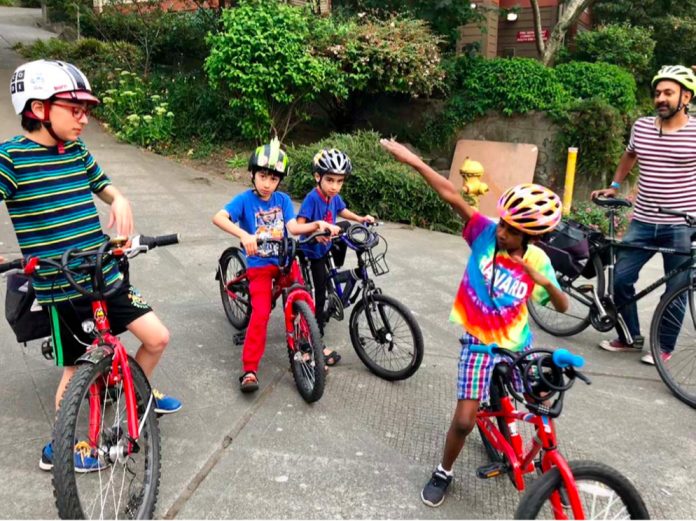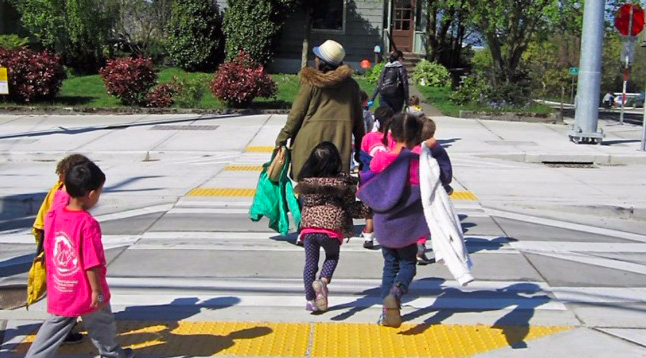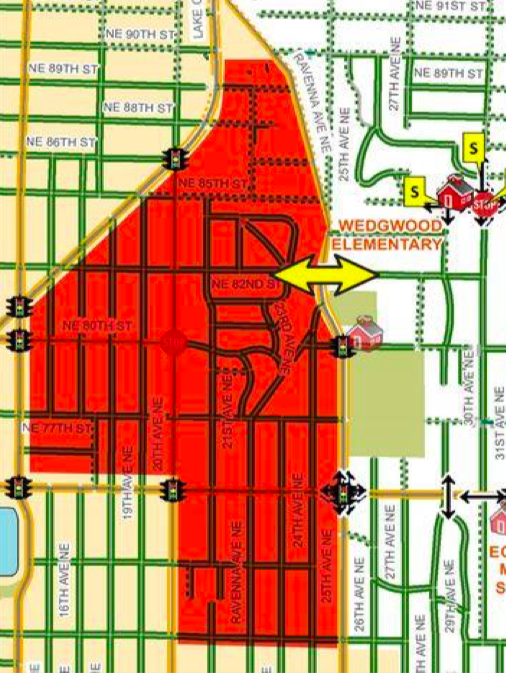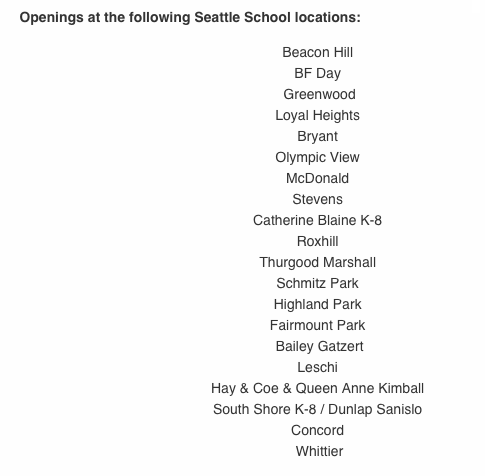
Missing infrastructure and a high crossing guard vacancy rate hamper Seattle students’ ability to walk or bike to school
Active transportation, which includes any kind of transportation based on physical activity, is universally acknowledged as beneficial for children and adolescents. Engaging children in active transportation has both immediate and longterm positive impacts on their physical and mental health, as research shows.
Of course to harness the many benefits of active transportation, children and adolescents need street infrastructure that supports their safety. Otherwise, the reward of engaging in these healthy activities could put them at significant risk–just as it did this March when a Robert Eagle Staff Middle School student was struck by a motorist while walking in a designated crosswalk outside of the school.
The student suffered a broken leg and is expected to make a full recovery. However, at the time of the accident, the vehicle responsible was only driving five to ten miles per hour; if it had been traveling faster, the outcome could have been much worse.
This story was shared at a recent meeting of the Seattle City Council’s Sustainability and Transportation Committee, in which the Seattle School Traffic Safety Committee shared the main findings from their 2019 annual report.
The Seattle School Traffic Safety Committee is a volunteer board that was created back in 1975. It is responsible for recommending new school crosswalk locations, crossing guard assignments, criteria for placement of crossing guards, and traffic circulation plans for schools. The committee also advocates for improvements to the systems, infrastructure, and oversight that create Seattle Public School’s transportation network. Their work prioritizes multi-modal transportation and seeks to get more students using active transportation in their school commute.

Calls for a citywide Active Transportation Coordinator
To this end, one of the committee’s primary demands in the 2019 report is to create a position for a district-wide Active Transportation Coordinator. Such a position would being several benefits to the District, the committee argues.
First of all, it would provide the administrative support necessary for Seattle Public Schools to qualify for King County’s School Pool program, which allows for parents to connect with neighbors to create walking, biking, and car pool groups. While this service is being used successfully in other King County cities such as Kirkland, Bellevue and Redmond, King County School Pool has not been expanded to Seattle Public Schools because of a lack of administrative support.
Additionally, an Active Transportation Coordinator would increase equity among schools in regards to walking and biking programs. Currently whether or not students and families engage in active transportation depends heavily on the PTA (Parent-Teacher Association) at their schools. Schools with strong PTAs tend to have more active promotion of walking, biking, and carpooling activities, while schools without strong PTAs do not. Because PTAs are run by parents of enrolled students, their membership fluctuates and changes overtime, which leads to instability.
The influence of PTA’s tends to create either a virtuous or vicious cycle in which students perceived feelings of safety or danger influence their commuting habits, the committee contends. Their goal is to ensure every school becomes part of a virtuous cycle that “spurs more families to choose walking, biking, and carpooling.”

Infrastructure and crossing guards identified as critical priorities
Beyond pushing more oversight of active transportation, the committee has identified four other top priorities that arose from the 2019 report, which included:
- Filling in 756,307 feet of missing sidewalk located within 1⁄4 mile of schools.
- Getting crossing guard vacancy rate from 39% to zero.
- Pushing WA State OSPI (Office of Superintendent of Public Instruction) funding formula to include crossing guards and other non-bus transportation support (the current formula favors financial support for districts with a majority of students who bus to school).
- Ensuring requirements for street improvements at schools are focused on enhancing student safety.
Currently, about half of Seattle students live within their school’s designated walk zones, which are broadly defined as one mile radius for elementary school and two miles radius for middle and high school.
However, many students who live within those geographic boundaries are not considered to be part of their designated walk zone because of unsafe road conditions and a lack of crossing guards at busy intersections. This results in more students identified as eligible for bus services.
A map of Wedgewood Elementary shows what an impact a lack of crossing guards has on the number of children who are able to walk to school. According to the Committee’s report, a crossing guard at the double headed arrow would move the area shaded in orange from bus service to being able to walk, reducing the need for busing.

Seattle Public Schools crossing guards’ wages currently start at $13 per hour. The work only takes place for a few hours in the morning and afternoon, making the schedule inconvenient for a lot of people. A review of open positions listed online shows how many schools across the city are impacted by the shortage.

Anger at the loss of red-light camera revenue
Last November, the Seattle City Council decided to change policy so that all revenue collected from red light cameras would contribute the City’s general fund. Previously twenty percent of revenue collected from red light cameras was used to fund school safety projects. The budget policy shift resulted in an estimated $2.7 million diverted away from school traffic safety projects over a three year period.
The Seattle School Traffic Safety Committee registered its unhappiness at the policy change during its presentation.
Councilmember Mike O’Brien, who is not seeking reelection this year, acknowledged that the he voted to support the funding changes, but suggested that the future City Council make a commitment to rededicate funding from red-light cameras for school safety projects and potentially increase the percentage of funding directed to these improvements. He also suggested expanding “the language around what encompasses a school safety project” to make sure a comprehensive array of potential projects could receive funding.
While school zone enforcement and red light camera fee revenue have successfully raised millions of dollars for school traffic safety projects, the goal such enforcement is to eliminate infractions. Thus achieving the goal would also eliminate funding. Last year, the University of Washington published a study indicating that school zone enforcement both successfully reduced the amount of drivers who sped through dedicated school zone areas and increased the amount of children who walked and biked there as well.
Still, the day in which enforcement is no longer necessary appears to be a long way off. According to the Seattle School Transportation Committee’s presentation, the school with the highest amount of school zone violation tickets in 2018 was Mercer Middle School in Beacon Hill. Mercer Middle averaged a whopping 826 school zone violation tickets issued each month, all the more shocking because enforcement occurred less than four hours per day and only on days in which school was in session. The current fine for a school zone speed infraction is $234.
The Seattle School Traffic Safety Committee is currently recruiting new volunteer members. To learn more check their their recruitment page.
Natalie Bicknell Argerious (she/her) is a reporter and podcast host at The Urbanist. She previously served as managing editor. A passionate urban explorer since childhood, she loves learning how to make cities more inclusive, vibrant, and environmentally resilient. You can often find her wandering around Seattle's Central District and Capitol Hill with her dogs and cat. Email her at natalie [at] theurbanist [dot] org.

